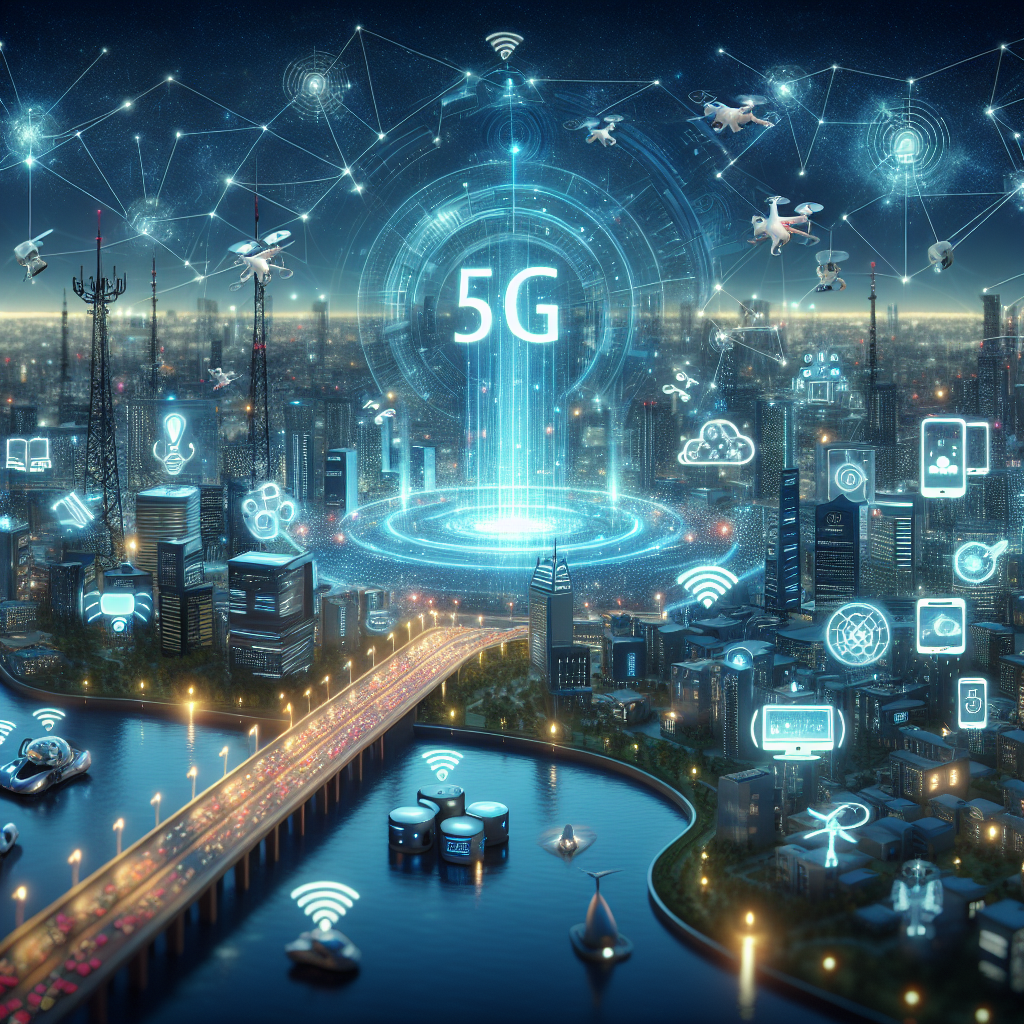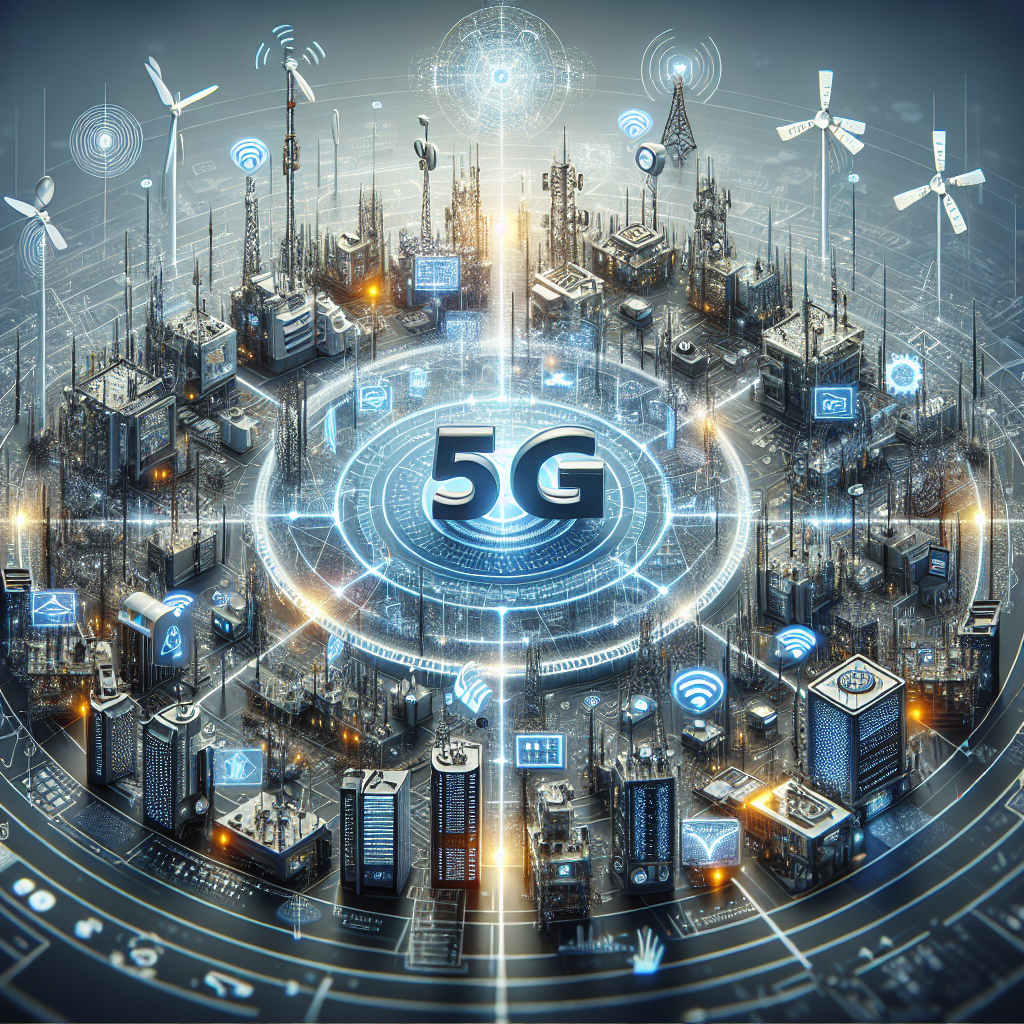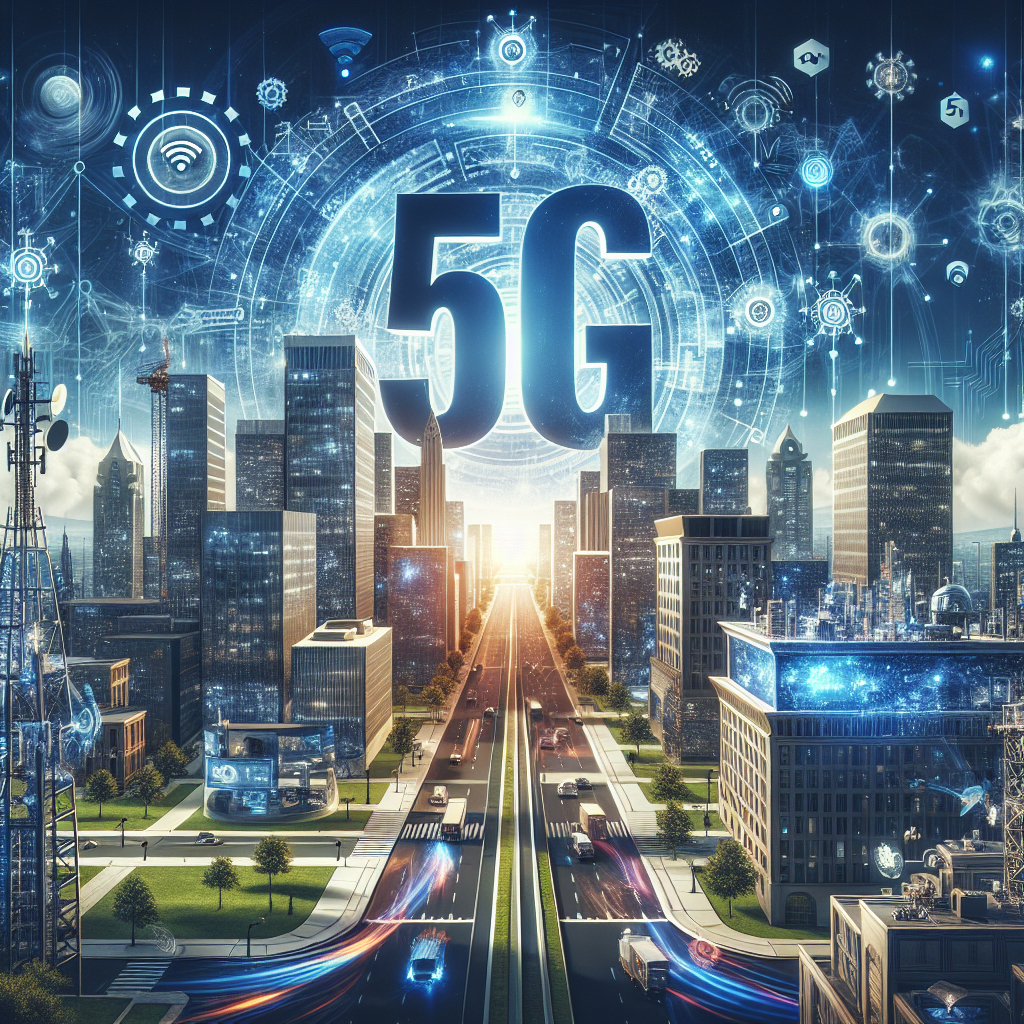The advent of 5G technology has undoubtedly sparked a new era in the realm of Internet of Things (IoT). This groundbreaking advancement is set to revolutionize the way we interact with connected devices, offering lightning-fast internet speeds, ultra-low latency, and unparalleled reliability. From smart homes to autonomous vehicles, the possibilities seem endless as 5G unlocks a world of potential for IoT applications. In this comprehensive analysis, we delve into the transformative impact that 5G technology is poised to have on IoT, exploring the myriad ways in which it will shape the future of connectivity and innovation. Join us as we unveil the thrilling potential of this dynamic duo in reshaping our digital landscape.
Understanding the Fusion of 5G Technology and IoT
In the realm of technological advancement, the convergence of 5G technology and the Internet of Things (IoT) has sparked a paradigm shift, unlocking a myriad of possibilities and reshaping the digital landscape as we know it. This section delves into the intricate fusion of these two cutting-edge domains, shedding light on their individual components and the transformative impact of their amalgamation.
Exploring the Fundamentals of 5G Technology
5G technology stands at the pinnacle of wireless communications, representing the fifth generation of mobile networks characterized by unprecedented speed, ultra-low latency, and massive connectivity. Leveraging advanced technologies such as millimeter waves, massive MIMO (Multiple Input Multiple Output), and beamforming, 5G offers blazing-fast data transmission rates, enabling real-time communication and immersive experiences like never before.
Defining the Internet of Things (IoT)
The Internet of Things (IoT) encapsulates a network of interconnected devices, sensors, and systems that communicate and exchange data seamlessly over the internet. IoT devices span a wide spectrum, ranging from smart home appliances and wearable gadgets to industrial machinery and autonomous vehicles. By harnessing the power of IoT, businesses and consumers alike can automate processes, monitor assets remotely, and gather valuable insights for informed decision-making.
Highlighting the Intersection of 5G and IoT
The synergy between 5G technology and IoT heralds a new era of innovation, unlocking unparalleled opportunities across various sectors such as healthcare, transportation, manufacturing, and agriculture. With 5G’s high bandwidth and low latency capabilities, IoT devices can operate with enhanced efficiency and responsiveness, paving the way for autonomous vehicles, smart cities, and interconnected smart grids. This convergence not only accelerates the deployment of IoT solutions but also catalyzes the development of next-generation applications that were once deemed unfeasible.
Enhancing Connectivity with 5G for IoT Devices

Speed and Bandwidth Improvements
Enhancing Connectivity with 5G for IoT Devices
- Discussing the unprecedented speed of 5G networks
5G technology offers unparalleled speed improvements for IoT devices, revolutionizing the way data is transmitted and processed. With speeds reaching up to 10 gigabits per second, 5G networks enable real-time communication between devices, enhancing efficiency and productivity in various industries. This rapid speed ensures minimal latency, crucial for time-sensitive applications in IoT, such as autonomous vehicles and industrial automation.
- Exploring the impact of increased bandwidth on IoT devices
The increased bandwidth provided by 5G networks allows for a higher volume of data to be transferred simultaneously, accommodating the growing number of connected IoT devices. This expanded capacity facilitates the seamless integration of IoT devices into various ecosystems, enabling extensive data collection and analysis. Moreover, the enhanced bandwidth supports the deployment of advanced IoT applications that require substantial data throughput, unlocking new possibilities for innovation in smart cities, healthcare, agriculture, and more.
Lower Latency Benefits
- Analyzing the significance of reduced latency in IoT applications
The integration of 5G technology in IoT systems brings about a significant reduction in latency, which is the time it takes for data to travel from one point to another. This reduced latency plays a crucial role in enhancing the overall performance and efficiency of IoT devices. With lower latency, IoT devices can communicate and respond to commands much quicker, leading to improved real-time data processing and decision-making capabilities.
- Examining real-time communication enhancements
Real-time communication is a key aspect of IoT applications, where instantaneous data exchange is essential for timely responses and actions. The low latency provided by 5G technology enables IoT devices to communicate seamlessly and without delays, even in highly dynamic environments. This real-time communication enhancement opens up new possibilities for IoT applications, such as autonomous vehicles, remote healthcare monitoring, and industrial automation, where split-second decisions can have a significant impact.
Empowering IoT Ecosystems with 5G Advancements
Improved Reliability and Stability
- Discussing the reliability enhancements offered by 5G technology
The deployment of 5G technology has significantly bolstered the reliability of IoT ecosystems by providing ultra-low latency and high data rates. This means that devices connected to the IoT network can communicate more efficiently and effectively, leading to more reliable data transmission and reduced downtime.
Moreover, 5G’s improved network slicing capabilities allow for the creation of dedicated virtual networks tailored to specific IoT applications. This customization enhances reliability by ensuring that each device receives the necessary resources and bandwidth, minimizing the risk of network congestion or failure.
- Exploring the impact on the stability of large-scale IoT deployments
In large-scale IoT deployments, stability is crucial to ensure seamless operations and prevent disruptions. 5G technology plays a pivotal role in enhancing stability by offering greater network capacity and scalability. This enables IoT devices to handle increased data traffic without compromising performance, thereby maintaining the stability of the overall ecosystem.
Furthermore, the advanced network management features of 5G, such as dynamic resource allocation and network orchestration, contribute to the stability of large-scale IoT deployments. These capabilities allow for real-time adjustments to network conditions, ensuring optimal performance and reliability even in dynamic and demanding environments.
Scalability and Flexibility
- Examining the scalability options for IoT networks with 5G
5G technology introduces a new era of connectivity for IoT ecosystems by enhancing scalability options to accommodate the increasing number of connected devices. With the capability to support a significantly higher density of devices per unit area compared to 4G networks, 5G enables IoT networks to scale seamlessly. This scalability is crucial for industries deploying IoT solutions that require a large number of interconnected devices to operate efficiently.
- Discussing the flexibility provided by 5G in adapting to IoT growth
Moreover, 5G technology offers unparalleled flexibility in adapting to the dynamic growth of IoT applications. The agility of 5G networks allows for swift deployment of new services and applications without compromising performance. This flexibility is essential for IoT ecosystems as they evolve and expand, enabling them to meet the changing demands of various industries. The ability of 5G to dynamically allocate resources based on the requirements of IoT devices ensures optimal performance and responsiveness, further enhancing the overall efficiency and effectiveness of IoT deployments.
Security Implications of 5G for IoT Infrastructure
- Highlighting the security challenges in IoT ecosystems
The integration of Internet of Things (IoT) devices into various industries has brought about unprecedented connectivity and data accessibility. However, this interconnectedness has also exposed IoT infrastructure to a myriad of security challenges. One of the primary concerns is the susceptibility of IoT devices to cyberattacks due to their often limited processing power and inadequate security measures. These vulnerabilities can be exploited by malicious actors to gain unauthorized access to sensitive data, disrupt operations, or even take control of the devices themselves. Additionally, the sheer volume of IoT devices being deployed amplifies the potential impact of security breaches, making it imperative to address these vulnerabilities effectively.
- Exploring how 5G technology can address security concerns
The emergence of 5G technology offers a promising solution to enhance the security of IoT infrastructure. One key advantage of 5G networks is their ability to provide increased bandwidth and lower latency, enabling faster and more secure communication between IoT devices. This improved connectivity can facilitate real-time monitoring and response to security threats, reducing the window of opportunity for cyberattacks. Furthermore, 5G networks utilize advanced encryption protocols and authentication mechanisms to ensure the integrity and confidentiality of data transmitted between devices. By leveraging these capabilities, organizations can fortify their IoT ecosystems against a wide range of cyber threats, safeguarding critical assets and maintaining the trust of their stakeholders.

Revolutionizing Industry Verticals through 5G-enabled IoT Applications
Healthcare Sector
- Analyzing the transformative impact of 5G on healthcare IoT solutions
In the healthcare sector, the integration of 5G technology with IoT solutions has brought about a revolutionary transformation. The high-speed, low-latency capabilities of 5G networks have paved the way for real-time monitoring, diagnosis, and treatment in healthcare settings. This has significantly enhanced the efficiency and effectiveness of healthcare services, leading to improved patient outcomes.
5G-enabled IoT devices can now collect and transmit vast amounts of patient data in real-time, allowing healthcare providers to monitor vital signs, track medication adherence, and even predict potential health issues before they escalate. This level of connectivity and data exchange was not possible with previous generations of technology, making 5G a game-changer in the healthcare industry.
- Discussing real-world examples of 5G-enabled healthcare innovations
One prominent example of 5G-enabled healthcare innovation is remote surgery. With the ultra-low latency of 5G networks, surgeons can now perform complex procedures on patients located miles away with precision and accuracy. This has the potential to revolutionize the field of telemedicine, bringing specialized medical care to underserved areas.
Additionally, the use of 5G-enabled IoT devices in hospitals has led to the development of smart healthcare systems. These systems can automatically adjust patient care protocols based on real-time data, optimize hospital workflows, and improve overall operational efficiency. For instance, IoT sensors integrated with 5G technology can monitor patient movement, track equipment usage, and ensure timely medication delivery, all contributing to a safer and more effective healthcare environment.
Smart Cities and Infrastructure
The integration of 5G technology with IoT has the potential to revolutionize the concept of smart cities by enabling a more connected and efficient urban environment. This fusion of technologies facilitates real-time data collection, analysis, and communication, paving the way for smarter decision-making processes and resource management within city infrastructure.
- Exploring the role of 5G in shaping smart city initiatives
5G technology plays a pivotal role in shaping smart city initiatives by providing high-speed, low-latency connectivity essential for supporting a myriad of IoT devices and sensors. With 5G networks, smart cities can leverage advanced data analytics and machine learning algorithms to optimize traffic flow, enhance public safety, and improve energy efficiency. The ultra-reliable and low latency communication capabilities of 5G are instrumental in enabling seamless connectivity among various IoT devices, enabling cities to respond swiftly to dynamic urban challenges.
- Highlighting the potential improvements in urban infrastructure with 5G-enabled IoT

The deployment of 5G-enabled IoT applications in urban infrastructure opens up a realm of possibilities for enhancing efficiency and sustainability. By leveraging IoT sensors powered by 5G connectivity, cities can monitor and manage critical infrastructure assets such as transportation systems, water supply networks, and waste management facilities in real-time. This enhanced visibility allows for proactive maintenance, optimized resource allocation, and improved overall operational efficiency. Additionally, the integration of 5G technology can enable the development of autonomous vehicles, smart grids, and connected public services, transforming urban infrastructure into a more responsive and adaptive ecosystem.
Future Prospects and Challenges in the 5G-IoT Landscape
Discussing the potential future advancements in 5G-enabled IoT applications
The integration of 5G technology with the Internet of Things (IoT) is set to revolutionize various industries and sectors. With the enhanced speed, lower latency, and higher capacity that 5G networks offer, the potential for innovative IoT applications is vast.
- Real-time Data Processing: 5G’s high-speed connectivity will enable IoT devices to process and transmit data in real-time, leading to instant responses and improved decision-making processes.
- Massive IoT Deployments: The scalability of 5G networks will facilitate the deployment of a massive number of IoT devices, creating interconnected ecosystems that can revolutionize smart cities, healthcare systems, and industrial processes.
- Enhanced Automation and Efficiency: The combination of 5G and IoT will drive automation to new levels, optimizing processes, reducing human intervention, and increasing overall efficiency in various domains.
Identifying key challenges and considerations for the seamless integration of 5G and IoT
While the future of 5G-enabled IoT applications holds immense promise, several challenges and considerations need to be addressed for seamless integration and optimal utilization of this technology landscape.
- Security Concerns: As the number of connected devices increases with the adoption of 5G technology, ensuring robust security measures to protect data and privacy becomes critical to prevent cyber threats and breaches.
- Interoperability Issues: The compatibility and seamless integration of diverse IoT devices and platforms with 5G networks pose a significant challenge. Standardization efforts are essential to ensure interoperability and smooth communication between devices.
- Network Infrastructure Upgrades: The deployment of 5G networks requires substantial investments in infrastructure upgrades to support the increased bandwidth and connectivity demands of IoT devices. Ensuring network reliability and coverage in both urban and remote areas is crucial for the success of 5G-enabled IoT applications.
FAQs: Unveiling the Revolutionary Impact of 5G Technology on IoT: A Comprehensive Analysis
How does 5G technology enhance IoT devices and applications?
5G technology brings higher data transfer speeds, lower latency, and increased network capacity, which directly impact the performance of IoT devices and applications. With 5G, IoT devices can communicate with each other faster and more efficiently, enabling real-time data processing and analysis. This results in improved overall performance and reliability of IoT solutions.
What are the key benefits of combining 5G technology with IoT?
The combination of 5G technology and IoT opens up a wide range of possibilities and benefits. It enables the deployment of more sophisticated IoT solutions, such as autonomous vehicles, smart cities, and industrial automation. The increased network capabilities of 5G also allow for more devices to be connected simultaneously without compromising performance, contributing to the scalability and expansion of IoT applications.
How does 5G technology impact the security and privacy of IoT devices?
5G technology offers enhanced security features, such as improved encryption protocols and network slicing, which can help address the security concerns associated with IoT devices. With 5G, IoT data can be securely transmitted and stored, reducing the risk of cyberattacks and data breaches. Additionally, 5G enables better authentication mechanisms and access controls, further enhancing the security and privacy of IoT devices and applications.
How does 5G technology influence the development of new IoT business models?
5G technology accelerates the development of innovative IoT business models by providing a solid foundation for the integration of emerging technologies, such as artificial intelligence, machine learning, and edge computing. With the high-speed and low-latency connectivity of 5G, businesses can create new revenue streams, improve operational efficiency, and deliver personalized services to customers. This transformation in connectivity and data processing capabilities opens up a range of opportunities for businesses to leverage IoT in novel ways.


